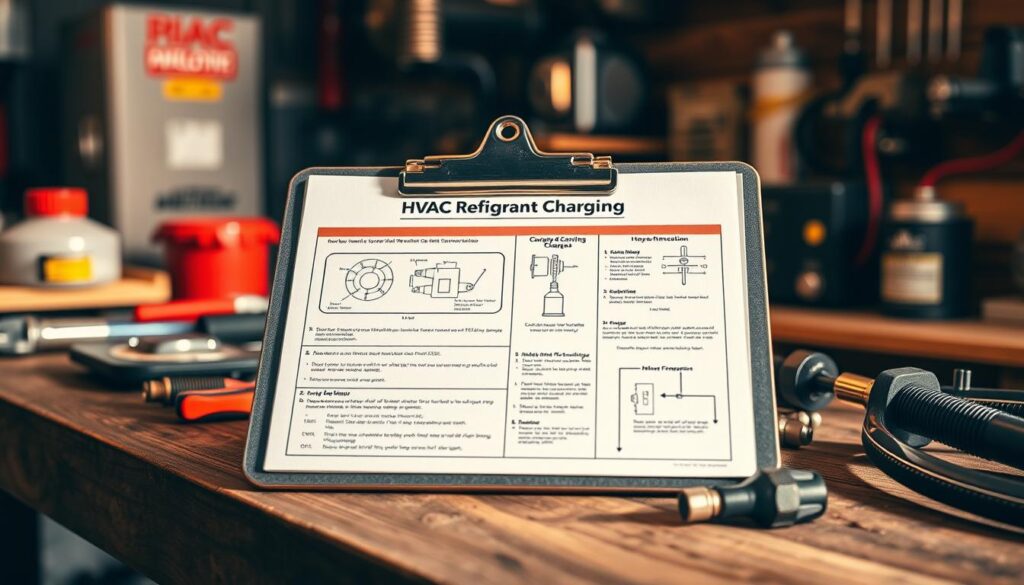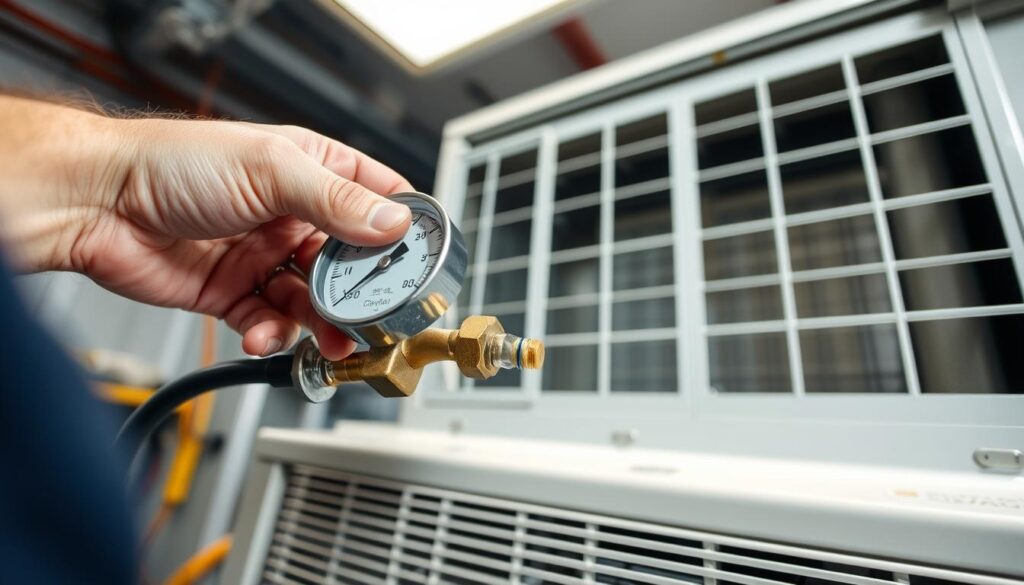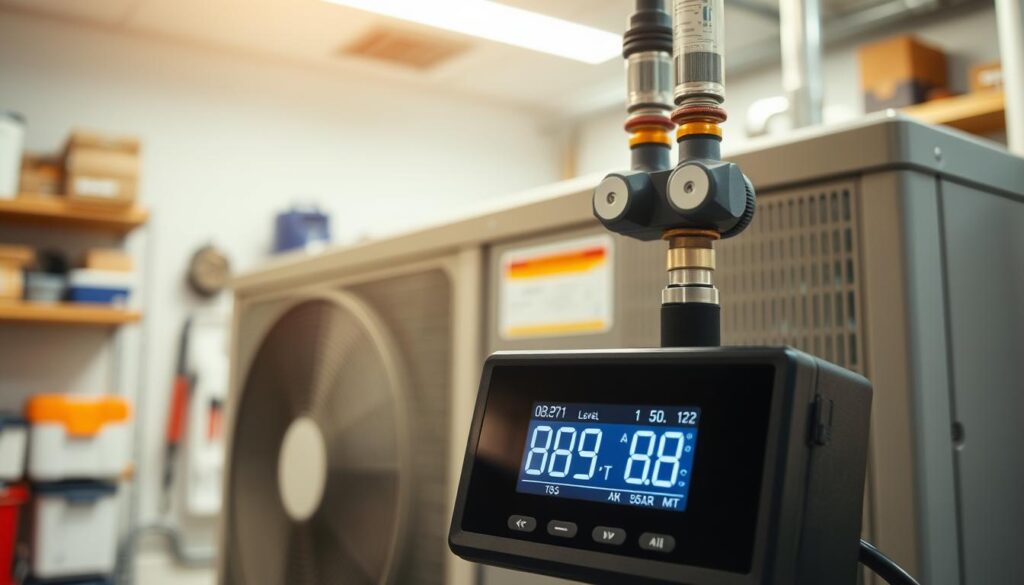Affiliate Disclosure
HVAC Guide Guys is a participant in the Amazon Services LLC Associates Program, an affiliate advertising program designed to provide a means for sites to earn advertising fees by advertising and linking to Amazon.
How to Add HVAC Refrigerant? Is your air conditioner not cooling your home well? Maybe adding HVAC refrigerant is the simple fix you need. It could bring back your system’s cool comfort.

Every air conditioner needs refrigerant to move heat from inside to outside. Charging the refrigerant is key to keeping your AC running smoothly. If the levels drop, your system works too hard, raising energy costs and risking damage.
This guide will show you how to safely and effectively add HVAC refrigerant. It’s perfect for DIY fans or anyone wanting to know more about their system. You’ll learn to handle refrigerant maintenance with ease.
Key Takeaways
- Proper refrigerant levels are crucial for AC system efficiency
- Low refrigerant can cause increased energy consumption
- Safety is paramount when handling refrigerant
- Professional tools are essential for accurate refrigerant charging
- Regular system maintenance prevents refrigerant issues
Table of Contents
Understanding HVAC Refrigerant Basics
Your air conditioning system needs refrigerant to work well. It’s key for cooling your home. Knowing about HVAC refrigerant types and levels helps keep your system running smoothly.
Refrigerant is like magic for your AC. It takes heat from inside and moves it outside. Without enough refrigerant, your AC can’t cool your home properly.
The Core Function of Refrigerant
HVAC refrigerant goes through a cycle of compression and expansion. It changes from liquid to gas and back, moving heat around. This lets your air conditioner make your home cool and comfy.
Common HVAC Refrigerant Types
- R-410A: Modern, environmentally friendly refrigerant
- R-22 (Freon): Phased out due to environmental concerns
- R-32: Emerging low-global warming potential option
- R-134A: Commonly used in automotive and some residential systems
Recognizing Low Refrigerant Levels
Spotting low refrigerant levels can prevent expensive fixes. Look out for these signs:
- Warm air blowing from vents
- Ice buildup on refrigerant lines
- Increased energy bills
- Unusual hissing sounds near the AC unit
Pro tip: Regular professional maintenance helps monitor hvac refrigerant types and ensure optimal system performance.
Explore Our HVAC Shop
Looking for top-rated HVAC tools, parts, and accessories? Visit our shop and find the perfect solution for your needs.
Visit the ShopSafety Considerations Before Adding Refrigerant
Adding refrigerant to your AC needs careful preparation and safety steps. It’s important to protect yourself and the environment when working with HVAC systems.
Essential Safety Equipment and Gear
Before starting, make sure you have the right safety gear. The right equipment helps avoid injuries and exposure to harmful chemicals.
- Chemical-resistant safety gloves
- Safety goggles with side shields
- Protective respirator or face mask
- Long-sleeved protective clothing
- Closed-toe work boots
Environmental and Legal Requirements
Working with refrigerants means following strict environmental rules. The Environmental Protection Agency (EPA) has specific guidelines for adding refrigerant to your AC.
- Obtain proper certification for refrigerant handling
- Follow EPA guidelines for refrigerant management
- Prevent refrigerant release into the atmosphere
- Use EPA-approved recovery and recycling methods
Optimal Weather Conditions for Refrigerant Addition
Temperature is key for a successful refrigerant recharge. Always add refrigerant when outdoor temperatures are at least 55°F. Cold temperatures can lead to wrong pressure readings and poor refrigerant spread.
Pro Tip: Always check local weather conditions before starting your HVAC maintenance project.
Required Tools and Equipment for Refrigerant Charging
Getting ready for an HVAC refrigerant refill needs the right tools and equipment. This ensures a safe and precise refrigerant recharge. Both professional HVAC technicians and skilled DIY folks need the right tools for this job.
- Manifold gauge set
- Digital refrigerant scale
- Protective safety goggles
- Refrigerant recovery machine
- Insulated gloves
- Thermometer
Your manifold gauge set is key for checking system pressures during the refill. The digital refrigerant scale lets you track the refrigerant amount accurately. This prevents adding too much or too little.
| Tool | Purpose | Estimated Cost |
|---|---|---|
| Manifold Gauge Set | Measure system pressures | $50-$200 |
| Digital Refrigerant Scale | Weigh refrigerant accurately | $100-$300 |
| Safety Goggles | Protect eyes from refrigerant | $10-$30 |
| Recovery Machine | Safely remove existing refrigerant | $500-$1500 |
Pro tip: Always invest in high-quality tools to ensure accurate and safe refrigerant recharge procedures.
Explore Our HVAC Shop
Looking for top-rated HVAC tools, parts, and accessories? Visit our shop and find the perfect solution for your needs.
Visit the ShopHow to Add HVAC Refrigerant: Essential Steps
Refrigerant charging is key to keeping your air conditioning system efficient. Before starting, it’s important to know the right steps and safety measures.
Getting your HVAC ready for refrigerant addition needs careful steps. You must follow a detailed approach to ensure your system works well and avoid damage.
System Preparation and Initial Checks
Begin with these important steps:
- Turn off the air conditioning system completely
- Verify the system’s power is disconnected
- Check the current refrigerant pressure using a professional manifold gauge set
- Inspect all connections and components for any visible damage
Connecting Manifold Gauges
Connecting manifold gauges correctly is crucial for accurate refrigerant charging:
- Locate the low-pressure service port (typically blue-coded)
- Attach the blue gauge hose to the low-pressure port
- Connect the red gauge hose to the high-pressure port
- Ensure all connections are tight and secure
Adding Refrigerant Safely
When adding refrigerant, follow these important guidelines:
- Wear appropriate safety equipment
- Add refrigerant slowly and carefully
- Monitor pressure gauges continuously
- Stop immediately if any unusual readings appear
Pro tip: Always refer to your specific HVAC system’s manufacturer guidelines for precise refrigerant charging instructions.
Identifying and Locating Service Ports
Knowing how to find service ports is key when replacing your AC system’s refrigerant. These small parts are vital for adding refrigerant. Most HVAC systems have two main service ports: low-pressure and high-pressure.
To find the right service port, look closely at your AC system’s refrigerant lines. The low-pressure line, which is bigger, is where you should connect your charging equipment.
- Low-pressure port: Usually located on the larger refrigerant line
- High-pressure port: Connected to the smaller refrigerant line
- Port color coding: Often marked with different colors for easy identification
Before you start adding refrigerant, remove the protective cap from the port. Make sure to wear gloves to avoid skin contact with refrigerant.
| Port Type | Characteristics | Charging Recommendation |
|---|---|---|
| Low-Pressure Port | Larger diameter line | Primary charging location |
| High-Pressure Port | Smaller diameter line | Not recommended for charging |
Pro Tip: Always check your system’s manual for the exact location of service ports. Different HVAC makers have different designs.
Finding the right service ports is a crucial first step. It helps keep your AC system running well and ensures a successful refrigerant recharge.
Explore Our HVAC Shop
Looking for top-rated HVAC tools, parts, and accessories? Visit our shop and find the perfect solution for your needs.
Visit the ShopProper Pressure Gauge Reading Techniques
Knowing how to read pressure gauges is key to understanding hvac refrigerant levels. Your HVAC system’s health depends on these accurate readings. They help spot problems and ensure the right amount of refrigerant.

Pressure gauge readings give you important info about your system’s refrigerant. Technicians use special tools to read these numbers. They show how well your cooling system is working.
Understanding Pressure Measurements
Pressure measurements tell you how well your HVAC system is doing. Important things to look at include:
- Low-side pressure readings
- High-side pressure readings
- Temperature correlations
- System efficiency indicators
Optimal Pressure Ranges
Every HVAC system has its own pressure range. For most homes, the low-pressure range should be between 25 and 45 psi. Always check your system’s manual for the exact numbers.
| System Type | Low Pressure Range | High Pressure Range |
|---|---|---|
| Residential Split System | 25-45 psi | 100-250 psi |
| Commercial Unit | 30-50 psi | 150-300 psi |
Troubleshooting Abnormal Readings
Odd pressure readings might mean you need more refrigerant or a system problem. Look out for these signs:
- Inconsistent pressure levels
- Significant temperature variations
- Unusual system noise
- Reduced cooling efficiency
Experts say to check your pressure gauges often. This keeps your system running smoothly and avoids big problems.
Connecting and Using the Refrigerant Cylinder
When you’re adding refrigerant to your AC, connecting the cylinder right is key. It makes sure you’re doing it safely and correctly. This avoids damage to your system.
First, get your safety gear ready. Also, make sure you have the right refrigerant for your HVAC system.
- Wear protective gloves and safety glasses
- Inspect the refrigerant cylinder for damage
- Check cylinder pressure and expiration date
To connect the refrigerant cylinder, follow these steps:
- Position the cylinder upright on a stable surface
- Attach the yellow charging hose to the cylinder valve
- Connect the opposite end to the manifold gauge set
- Ensure all connections are tight and secure
Knowing how to use the valves is important. Move slowly and carefully. This helps avoid sudden pressure changes that could harm your system.
| Cylinder Connection Steps | Key Considerations |
|---|---|
| Valve Attachment | Use appropriate adapters for specific refrigerant types |
| Pressure Verification | Check manufacturer specifications before charging |
| Hose Connection | Verify leak-free seal on all connections |
Remember, precision is crucial when connecting your refrigerant cylinder. Take your time, follow the manufacturer’s guidelines, and always put safety first during the ac refrigerant top up process.
Explore Our HVAC Shop
Looking for top-rated HVAC tools, parts, and accessories? Visit our shop and find the perfect solution for your needs.
Visit the ShopMonitoring System Performance During Charging
Proper refrigerant charging needs careful system performance monitoring. As you add refrigerant, track key indicators. These show how well the system works and its efficiency.

Temperature Differential Checks
Tracking temperature differences is key during refrigerant charging. Use a digital thermometer to measure air temperature at supply and return vents. A good HVAC system should show a 15-20 degree Fahrenheit temperature drop during charging.
- Measure supply vent temperature
- Check return air temperature
- Calculate the temperature differential
System Response Indicators
Watch for specific signs during hvac refrigerant levels adjustment. These show if the system is charged right:
- Airflow improvement: Strong and steady air circulation
- Faster cooling
- Less system strain
- Stable temperature
Stop adding refrigerant when you see the best system performance. Too much refrigerant can harm your HVAC and lower its efficiency. Always aim for precision in refrigerant charging to keep your equipment running at its best.
Common Mistakes to Avoid When Adding Refrigerant
Adding refrigerant needs to be done with care. Many people make mistakes that can harm their HVAC system. These errors can also make the system less efficient.
- Overcharging the system with excess refrigerant
- Using incorrect refrigerant type
- Misreading pressure gauges
- Skipping leak detection before recharging
Knowing the common mistakes in refrigerant leak repair can help avoid costly repairs. Experts say to avoid these mistakes to keep your HVAC system running well.
| Mistake | Potential Consequences |
|---|---|
| Overcharging | Reduced cooling efficiency, compressor damage |
| Wrong Refrigerant | System malfunction, potential permanent damage |
| Improper Gauge Reading | Incorrect refrigerant levels, poor system performance |
Professional HVAC technicians stress the need to follow the manufacturer’s guidelines. When in doubt, always consult a certified professional to prevent costly mistakes during refrigerant recharge procedures.
“Precision is key in refrigerant management. One small error can compromise your entire cooling system.”
Keeping your HVAC system in good shape means knowing these important maintenance steps. It also means knowing when to call a professional.
Explore Our HVAC Shop
Looking for top-rated HVAC tools, parts, and accessories? Visit our shop and find the perfect solution for your needs.
Visit the ShopPost-Charging System Verification
After you replace the ac system refrigerant, you need to check the system thoroughly. This step is crucial to make sure everything works right. It helps find any problems and confirms your HVAC system is in good shape.
First, check these important parts during your hvac refrigerant refill check:
- Condenser fan operation
- Blower motor functionality
- Airflow consistency
- Temperature output
Listen for odd sounds and watch for smooth movements. The condenser fan and blower motor should run smoothly without any weird noises or shakes.
| Performance Metric | Ideal Condition | Action if Abnormal |
|---|---|---|
| Airflow Temperature | 15-20 degrees cooler than ambient | Recheck refrigerant levels |
| System Pressure | Within manufacturer specifications | Adjust or consult professional |
| Mechanical Noise | Minimal, consistent sound | Inspect for potential mechanical issues |
Pro tip: If you notice anything off during your check, get an HVAC expert’s help. This can prevent serious damage later on.
By carefully checking your system after adding refrigerant, you’ll keep it cooling well. This also helps your air conditioning unit last longer.
Conclusion
Learning to add HVAC refrigerant needs careful attention and respect for complex processes. Your AC system’s performance depends on the right refrigerant levels. Too little or too much can cut efficiency by up to 20%.
Refrigerant recharge requires knowledge, precision, and a commitment to quality. It’s not just about following steps; it’s about doing it right.
Safety and protecting the environment are key when working with refrigerant. While you can do some maintenance yourself, complex issues need a pro. Knowing how to manage refrigerant keeps your system working well and helps the planet.
Regular maintenance stops refrigerant problems and keeps your AC cool. Knowing the latest HVAC rules and best practices helps you care for your system. Experts say getting your system checked often can avoid expensive fixes.
Learning to add HVAC refrigerant lets homeowners keep their homes cool and efficient. Spending time learning these skills can save you money and make your AC last longer.

